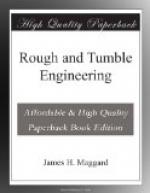If the injector is so hot that it will not lift the cold water, there is no way of cooling it except by applying the water on the outside. This is most effectively done by covering the injector with a cloth and pouring water over the cloth. If, after the injector has become cool, it still refuses to work, you may be sure that there is some obstruction in it that must be removed. This can be done by taking off the cap, or plug-nut, and running a fine wire through the cone valve or cylinder valve. The automatic injector requires only the manipulation of the steam valve to start it. There are other makes that require, first: that the injector be given steam and then the water. To start an injector requires some little tact, (and you will discover that tact is the handiest tools you can have to make you a good engineer). To start an injector of the Pemberthy type; first give it sufficient steam to lift the water, allowing the water to escape at overflow for a moment or long enough to cool the injector, then with a quick turn shut off and open up the supply which requires merely a twist of the wrist.
If the injector fails to take hold at once don’t get ruffled but repeat the above move a few times and you will soon start it, and if you have tact, (it is only another word for natural ability) you will need no further instructions to start your injector. But remember that no injector can work coal cinders or chaf and that all joints must be air tight. Don’t forget this.
It is now time to give some attention to the heater. While the heater is no part of the pump, it is connected with it and does its work between the two horizontal check valves. Its purpose is to heat the water before it passes into the boiler. The water on its way from the pump to the boiler is forced through a coil of pipes around which the exhaust steam passes on its way from the cylinder to the exhaust nozzle in the smokestack.
The heaters are made in several different designs, but it is not necessary to describe all of them, as they require little attention and they all answer the same purpose. The most of them are made by the use of a hollow bedplate with steam fitted heads or plates. The water pipe passes through the plate at the end of the heater into the hollow chamber, and a coil of pipes is formed, and the pipe then passes back through the head or plate to the hot water check valve and into the boiler.
The steam enters the cylinder from the boiler, varying in degrees of heat from 300 to 500. After acting on the piston head, it is exhausted directly into the chamber or hollow bed-plate through which the pipes pass. The water, when it enters the heater, is as cold as when it left the tank, but the steam which surrounds the pipes has lost but little of its heat, and by the time the water passes through the coil of pipes it is heated to nearly boiling point and can be introduced into the boiler with little tendency to reduce the steam. This use of the exhaust steam is economical, as it saves fuel, and it would be injurious to pump cold water directly into a hot boiler.




